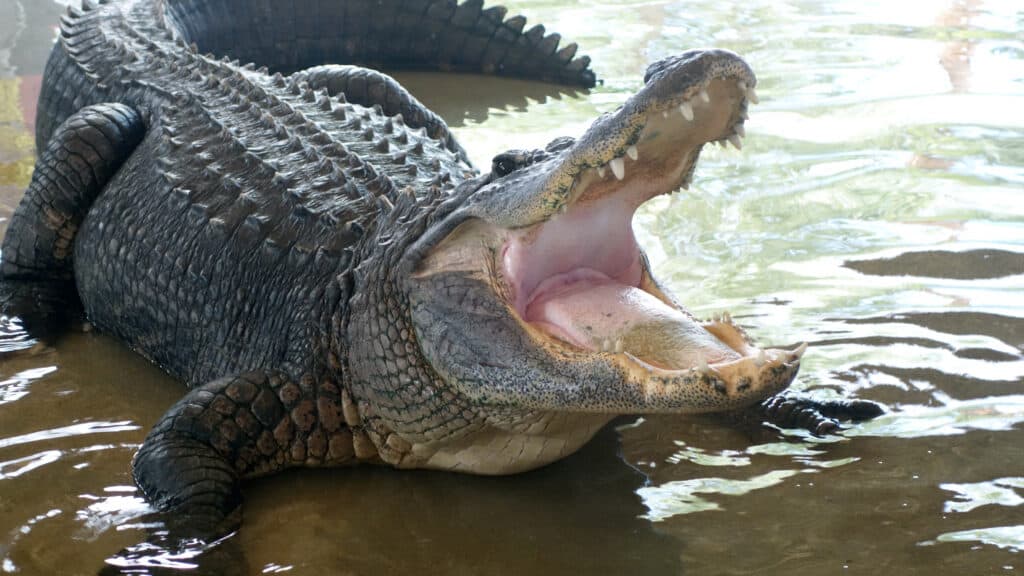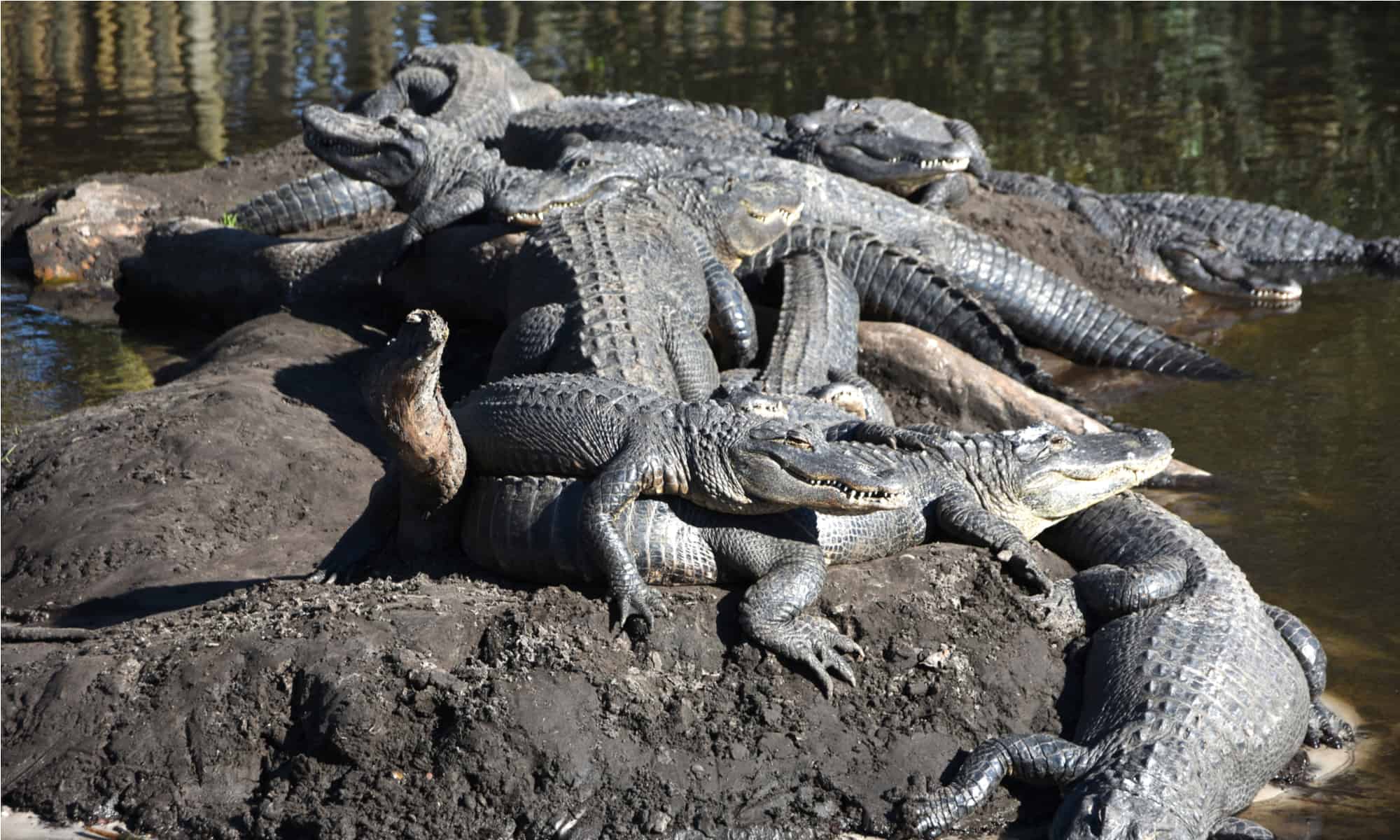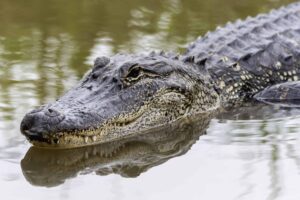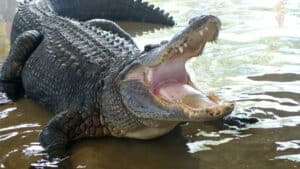Alligators captivate many people. Despite existing for millions of years, these reptiles still amaze us today.
Alligators are truly intriguing animals. But they are often referred to as crocodiles by mistake. In a sense, it’s kind of accurate. Alligators belong to the Crocodilia order of large reptiles, which also includes crocodiles, caimans, and gharials. What distinguishes alligators from crocodiles is actually the look of their snouts. Alligators have shorter, wider snouts than crocodiles, who have longer, narrower snouts.
China and the Southeast of the United States are home to alligators. Alligators can be found in Florida, Louisiana, Georgia, South Carolina, and Mississippi in the United States. But how do we refer to a bunch of alligators? This question has baffled many individuals, but the answer is quite simple.
We shall discover more about the name of a group of alligators in this article, along with some intriguing information about them. Let’s start by breaking down the basics of what an alligator actually is.
What are Alligators?
The family Alligatoridae, which also contains caimans, comprises alligators. Alligators are big, semi-aquatic reptiles. They are indigenous to portions of Central and South America as well as the southern United States, including Florida and Louisiana. As cold-blooded creatures, alligators’ body temperatures are controlled by their surroundings.
Alligators are known for having long, strong tails that they utilize to swim through the water, which is one of their distinguishing traits. Additionally, they have powerful, muscular jaws that are loaded with teeth. Alligators may grow to a length of six to 14 feet and weigh up to a whopping 1,000 pounds as adults.
As carnivorous creatures, alligators consume a range of prey, including fish, birds, turtles, and small mammals. They are opportunistic hunters and will utilize any source of food that is offered to them. Additionally, alligators have a reputation for being calm hunters that wait patiently for their prey to approach before striking.
Both as predators and as prey, alligators are crucial to their ecosystems. By maintaining a healthy population, they aid in the management of other animal populations. Their presence can support the health of wetland ecosystems and their nests serve as homes for other species.
Humans and Alligators
Since ancient times, alligators have been a part of human culture. Many Native American tribes view them as sacred creatures. Alligators have grown to be popular attractions at zoos and other animal parks in contemporary times. Alligator hunting is still carried out in select regions of the United States.
Alligators have recently experienced serious dangers to their existence, such as habitat loss and poaching. Alligator populations have been protected by conservation initiatives, and many locations have seen a rise in alligator populations as a result of these protections. The presence of alligators in wetland settings is an indication of a functioning ecosystem and serves as a reminder of the diversity and significance of the natural world.

The alligator (pictured) is similar to a
crocodile
, except it has a shorter and wider snout.
©Sorbis/Shutterstock.com
Alligator Congregations: All in the Family
So what do you call a group of alligators? A congregation of alligators is the most common term for a group of alligators. This term refers to a group of humans or animals. It can also refer to a group of individuals who have assembled for religious purposes.
Alligators can collectively be referred to as a congregation. However, they are also sometimes known as a family of alligators, though this term is less common. A meeting of a gathered body is most frequently referred to as a congregation. In the world of alligators, the smaller and younger alligators submit to the dominant adult in any one congregation or family of alligators.
A few other terms for a group of alligators include a bask of alligators, a gang of alligators, a den of alligators, or even a coterie of alligators.
What is a Group of Baby Alligators Called?
A congregation is a gathering of adult alligators. A pod is a gathering of juvenile alligators. A female alligator can lay 20 to 50 eggs at a time; the young of an alligator is known as hatchlings.
Mother crocodiles and mother alligators are ferocious guardians that keep eggs in their jaws as they anticipate hatching. By rotating the eggs around her mouth until they hatch, the mother facilitates the hatching process. The mother alligator descends to the nest after the eggs hatch and brings her offspring to the water. During the first one to two years of their existence, mother alligators take care of their young and educate them on how to survive. This is pretty rare in the reptilian world!
When baby alligators remain together, their mothers can easily keep an eye on them and safeguard their young. When they are old enough to care for themselves, she then departs, leaving them on their own. Baby alligators need two to three years to grow independent and leave their mother’s side. If required, the mother alligator will shield young alligators from predators as they grow.

Mother alligators will take care of their young (pictured) for several years until they are ready to live on their own.
©iStock.com/Casanowe
Why Do Alligators Group Together in Congregations?
Alligators are really fairly gregarious reptiles who have no trouble sharing space with other creatures of their species, despite the fact that they may not always appear to be friendly. However, there are certain factors outside social contact that lead them to gather into congregations.
Protection
Across the majority of the planet, alligators are the top apex predators. But they must grow into the position, just like other apex predators. Adult alligators in the United States are only threatened by humans and themselves once they have outgrown all other predators. Young alligators are vulnerable to several dangers up until the point that they start to get larger and more deadly.
Approximately five out of every 38 hatchlings from an average-sized clutch will mature into adults, which is a relatively low ratio. It is commonly known that mother alligators zealously guard their living young. From the moment they are hatched until they are ready to face the world on their own, mother alligators will take great pains to keep their babies safe. About two to three years after hatching, young alligators separate from their mother.
Mothers will gather together to safeguard their young from any nearby predators that are capable of taking on and devouring young before it is time to venture out into the world. From infancy until they reach adulthood, they are in danger from birds, bobcats, snakes, otters, largemouth bass, raccoons, and mature alligators. Yes, mom alligators have to defend their children from adult (usually male) alligators! This enormous predator does not engage in cannibalism, thus moms are extremely wary when a large male approaches.
Being a part of a congregation offers the protection and strength that comes from numbers. Any natural predator that isn’t an adult male alligator trying to snare a baby gator for a fast meal would probably perish from a swarm of older mother alligators.
Basking
Both the surface of a body of water and the banks and shoreline of rivers, streams, lakes, ponds, and marshes can be used for sunbathing. The habitat of alligators is severely constrained by the intensity of the sun and the consistency of temperature throughout the year.
Instincts for hibernation start to take over if temperatures go too low, encouraging the gator to sleep for a very long time, as is also common for other reptiles and certain mammals. Alligators often can be seen basking in the sun together when they are gathered together in a group.
As cold-blooded creatures, alligators rely extensively on whatever source of heat they can locate. Being near one another while sunbathing causes them to transmit heat toward one another, warming their blood and assisting in the maintenance of a manageable body temperature.
Food
Again, there is strength in numbers. And when it comes to being potential prey, escaping a large group of alligators is no easy task. A group of alligators will share a kill with others in addition to lazing around, soaking up the sun, and radiating heat toward one another.
Given that other alligators would push themselves upon another alligator’s kill, stealing any food it can find, this “sharing” isn’t always consensual. This conduct starts a chain reaction that is often compared to a feeding frenzy.
Do Male Alligators Live in a Congregation?
There is no evidence that male alligators dwell in congregations or groups. Instead, they tend to live alone, particularly during the mating season. Male alligators are known to be territorial and violent against one another, and they are known to protect their territory against other males. They can also be a danger to baby alligators.
Male alligators will move about in quest of females during the mating season, which normally lasts from April to June. They do not, however, establish social groupings or structures during this period. Instead, they fight over mate rights and compete with one another for access to females.
Alligator males may occasionally be observed together, such as when they are sunbathing in the sun or hunting together, but they do not create social relationships or cooperate with one another. Instead, they are often solitary creatures who want to be alone.
On the other hand, during the breeding season, it is known that female alligators form compact groupings known as pods. This activity is believed to aid in protecting the nests from predators and may also offer the moms and their young a certain amount of social support.

Male alligators (pictured) can be quite aggressive with one another during the mating season.
©Ernie Hounshell/Shutterstock.com
How Many Alligators Live in an Average Congregation?
Alligators can be quite social creatures, as mentioned earlier. However, they can also have the tendency to be solitary animals that prefer living on their own. Alligators can be found together at specific periods of the year. The mating season is one instance. When they need to bask for heat is another.
It is crucial to remember that while occasionally living near one another, alligators do not build human-like social relationships or exhibit cooperative behavior. In contrast to many other species, alligators are solitary creatures who prefer to live by themselves. They do not dwell in communities or groups long-term. That being said, there can be a wide range of alligators in any one congregation. There may be a dozen or more baby alligators present, together with their mother. A congregation can also include a number of other mothers and their babies, as well as some males.
Alligators are unusually social reptiles, though they don’t have the tendency to grow close relationships or stay in groups long-term. And if you happen to come upon a congregation of alligators, you should probably turn the other way!
Thank you for reading! Have some feedback for us? Contact the AZ Animals editorial team.








